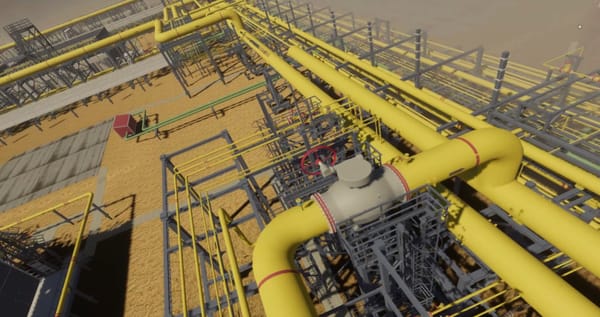Revolutionising Fire Safety Training: How VR is Changing the Game
Imagine you're in the middle of a typical workday when suddenly, an alarm blares, signalling a fire. Panic sets in, and you're unsure of the safest way out. This scenario is a nightmare, but it’s one many are unprepared for.

Imagine you're in the middle of a typical workday when suddenly, an alarm blares, signalling a fire. Panic sets in, and you're unsure of the safest way out. This scenario is a nightmare, but it’s one many are unprepared for.
Traditional fire safety training often falls short in preparing employees for real-life emergencies.
Enter Virtual Reality (VR), a game-changer in the world of fire safety education.
The Problem with Traditional Fire Safety Training
Think back to the last time you sat through a fire safety training session. It probably involved a mix of classroom lectures, instructional videos, and maybe the occasional fire drill. While these methods are essential, they often fall flat when it comes to preparing employees for the high-stress reality of a fire emergency.
Traditional training sessions can be incredibly monotonous. Sitting in a room, watching videos, and listening to lectures about what to do in case of a fire doesn't exactly ignite excitement or engagement. And let’s be honest, it’s easy to zone out or forget most of what you’ve learned when it's delivered in such a dry format.
Moreover, these training methods rarely simulate the panic and urgency that accompany real fires. Fire drills, while useful, are often scheduled and predictable, lacking the element of surprise that makes a real fire so dangerous. This controlled environment doesn’t effectively prepare employees to make quick, critical decisions under pressure.
With VR training, everyone gets direct eye contact with the trainer.
Enter Virtual Reality: A Game-Changing Solution
This is where Virtual Reality (VR) steps in, offering a fresh, engaging, and incredibly effective approach to fire safety training. VR immerses you in a lifelike fire scenario, allowing you to experience the chaos and stress of a real emergency without the actual danger. It’s like stepping into a high-stakes video game, but with real-world applications that could save lives.
Immersive Learning Experience
VR creates a fully immersive environment where you can see, hear, and even feel the sensations of a fire emergency. Picture this: you put on a VR headset, and suddenly, you’re in your office building. Smoke begins to fill the room, the fire alarm blares, and you need to navigate your way to safety. This type of immersive experience is far more impactful than simply reading about fire exits or watching a video.
In this virtual setting, you get to practice the correct procedures for different types of fires. Whether it’s using a fire extinguisher, finding the nearest exit, or assisting a colleague, VR allows you to rehearse these actions in a realistic, risk-free environment.
Engagement and Retention
One of the biggest advantages of VR training is its ability to engage users. The interactive nature of VR keeps you focused and involved, which naturally leads to better retention of information. Instead of passively absorbing information, you’re actively participating in your own learning experience. This hands-on approach helps solidify the knowledge and skills you need to respond effectively in a real fire emergency.
Realistic Stress Simulation
A crucial aspect of VR fire safety training is its ability to simulate the stress and urgency of a real fire. The realism of VR scenarios triggers genuine emotional and physical responses, helping you understand how you might react under pressure. This realistic stress simulation is invaluable because it prepares you to remain calm and make quick, informed decisions during an actual emergency.
Customisable Training Scenarios
Another fantastic benefit of VR training is its flexibility. Training programs can be customized to fit different workplace environments and specific fire hazards. Whether you work in an office, a factory, or a warehouse, VR scenarios can be tailored to replicate the unique challenges and risks of your particular setting. This customization ensures that the training is relevant and practical for every employee.
The Future of Fire Safety Training
The potential of VR in fire safety training is immense, and we’re only scratching the surface of what’s possible. As VR technology continues to evolve, so will the sophistication and effectiveness of training programs. Imagine future VR scenarios incorporating advanced AI to adapt to your actions in real-time, creating even more dynamic and personalized training experiences.
Moreover, VR training can be conducted remotely, making it accessible to employees regardless of their location. This is particularly beneficial for global companies with dispersed teams, ensuring that all employees receive consistent, high-quality training.
Real-World Success Stories
Several companies have already begun to embrace VR for fire safety training, with impressive results. For example, ExxonMobil uses VR to train its employees on emergency response procedures, including fire safety. Their VR training program has significantly improved employee engagement and retention of safety protocols.
Similarly, Siemens has developed a VR fire safety training module that allows employees to practice evacuation procedures in a controlled, virtual environment. This innovative approach has enhanced the company’s overall safety culture, empowering employees to respond confidently in emergency situations.

How to Get Started with VR Fire Safety Training
If you’re interested in bringing VR fire safety training to your workplace, there are a few steps to get started:
- Research Providers: Look for reputable companies that specialize in VR training solutions. Ensure they have experience in creating fire safety training programs.
- Assess Your Needs: Evaluate the specific fire hazards and emergency procedures relevant to your workplace. This assessment will help in customizing the VR training scenarios to fit your needs.
- Invest in Equipment: VR training requires headsets and other equipment. Consider the costs and logistics of acquiring and maintaining this technology.
- Pilot the Program: Start with a pilot program to test the effectiveness of VR training with a small group of employees. Gather feedback and make any necessary adjustments before rolling it out company-wide.
- Continuous Improvement: VR technology is constantly evolving, so stay updated on the latest advancements and continuously seek ways to enhance your training program.
What does all this mean?
Virtual Reality is revolutionizing fire safety training, transforming it from a mundane task into an engaging, immersive, and highly effective learning experience. By simulating realistic fire scenarios, VR prepares employees to handle emergencies with confidence and composure. As more companies adopt this cutting-edge technology, the future of fire safety training looks brighter and safer than ever.
Have you experienced VR fire safety training? Share your thoughts and experiences in the comments below! And if you think your workplace could benefit from this innovative training method, share this blog with your colleagues and start the conversation about bringing VR into your fire safety training program.
Note: Video's provided by friends at LikeXR👇









